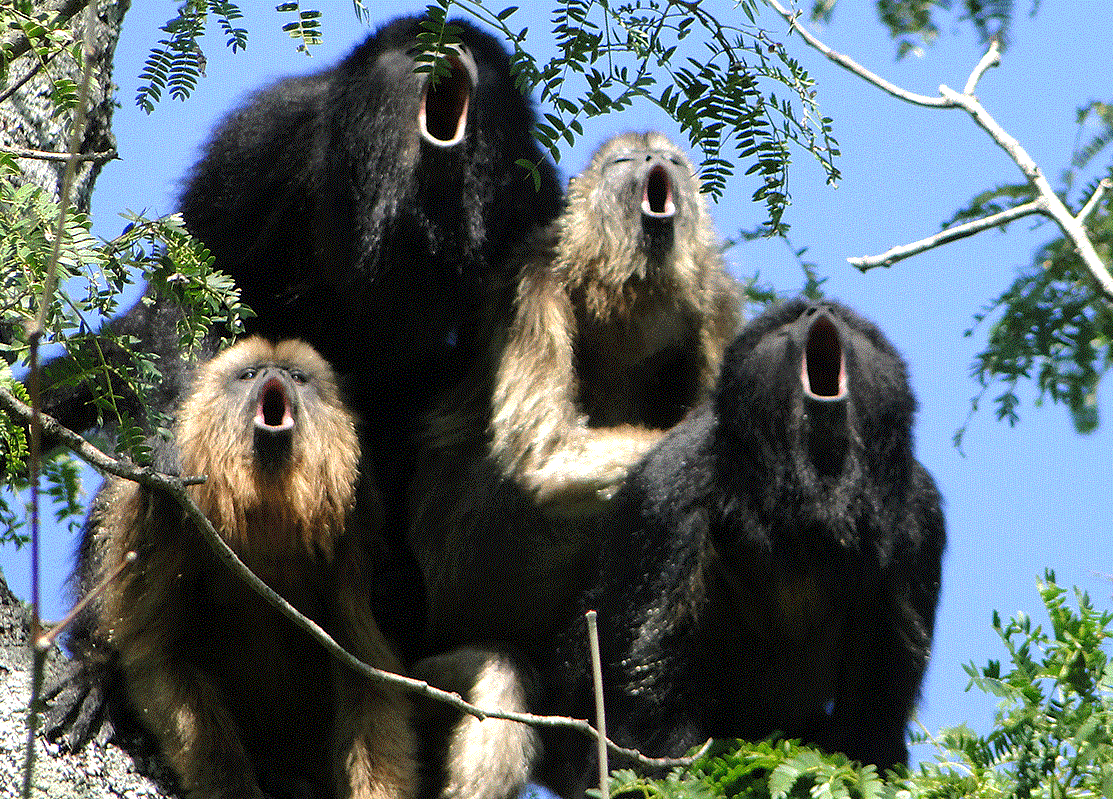
蛋蛋换声音
Howler Monkeys Trade Testicles for Decibels
蛋蛋换声音
Among howler monkey species, loud calls come at the expense of testicle size and sperm production—or to put it another way, monkeys with the largest testes don't make as much noise
在吼猴种群中,洪亮的叫声是以睾丸的大小与精子的质量作为代价——反之,睾丸很大的吼猴叫声并不响亮。
撰文/播音 詹森·戈德曼(Jason G. Goldman)
翻译 M
审核 邰伦玥
[Howler monkey calls]
【吼猴的叫声】
Howler monkeys. From their Central and South American rainforest home, they produce some of the loudest animal calls in the world. They’re about the size of an adult cocker spaniel, but they can sound as large as a tiger.
吼猴,来自美洲中部和南部的雨林。它们是世界上能发出最为响亮的叫声的动物之一。它们的大小和成年可卡犬相仿,但他们的叫声响亮可以媲美老虎。
Biologists have long suspected that the monkeys’ howls played a role in attracting mates. The sounds are like the auditory version of peacock feathers or deer antlers that say, hey, check me out.
生物学家长期怀疑吼猴的叫声是用于吸引伴侣。这叫声就像孔雀的羽毛或是鹿角的功能一样,仿佛在说,“看看我”。
And now we know that the quality of the howl depends on a bone near their throats called the hyoid. The bigger the hyoid, the deeper the howl. Males with deeper calls sound more attractive to females. Which means that males with smaller hyoids had to come up with another strategy.
现在,我们知道叫声的质量取决于在他们咽喉中的一块骨头——舌骨。舌骨越大,叫声越为深沉。具有深沉嗓音的雄性能更好地吸引异性。因此,具有小号舌骨的吼猴只能寻求另一种求偶策略。
“When you’re in the field and you look up at the monkeys, you notice that in Alouatta palliata, the mantled howler monkey, that the testes are huge. And they’re white, they’re really obvious.”
“若你能身在雨林中,抬头看那些猴子,你会发现鬃毛吼猴,这种长毛吼猴的睾丸相当巨大,因为它们的睾丸是白色的,相当显眼。”
University of Utah anthropologist Leslie Knapp. She her team found that howler monkeys face an anatomical trade-off: a species can either have a really big hyoid bone, or it can be very well endowed. But not both. That finding is in the journal Current Biology. [Jacob C. Dunn et al, Evolutionary Trade-Off between Vocal Tract and Testes Dimensions in Howler Monkeys]
犹他州大学的人类学家,莱斯利·克纳普与她的团队发现,在解剖学上,吼猴都在身体构造上做出了权衡:要么选择一个相当出众的舌骨,要么具有很好的生殖能力,但两者不可兼得。这个发现发表在《当代生物》上。
Those species with bigger hyoids live in single-male groups, so it makes sense to invest in what the researchers call “precopulatory traits,” that is, their courtship strategy of attracting the female’s attention.
那些具有更大的舌骨的物种生活在单一雄性的族群里,因此它们的身体结构偏向于这种“交配前特征”是有道理的。这种“交配前特征”是它们吸引异性注意的求爱策略。
But in a species where groups include multiple males, the best way to ensure passing on more genes is to make more sperm—by building bigger testes.
然而,在多雄性族群的物种中,确保能产生更多后代的最佳方式,无疑是产生更多的精子——这就需要更大的睾丸。
The researchers say the finding is the first evidence for an evolutionary trade-off between mating calls and sperm production. And they warn that while human women do tend to prefer males with deeper voices, we men advertise ourselves in many other ways as well. So don’t go clicking that pop-up ad that promises to enlarge your hyoid.
研究人员认为这项发现是进化上在求偶呼叫与精子生产之间的权衡的首个证据。并且,他们警告说,虽然人类女性确实垂青于嗓音深沉的男性,但我们男性有很多其他的方面来展现自己,所以不要随便相信那些说可以增大你的舌骨的弹出广告。
未经书面许可任何人不得复制或镜像
京ICP备11000850号-1
 京公网安备11010502039775号
京公网安备11010502039775号 信息网络传播视听节目许可证0111611号
国家科技基础条件平台

















